

Building trust in government. To be sure, there is a distribution of results across the agencies in this group.
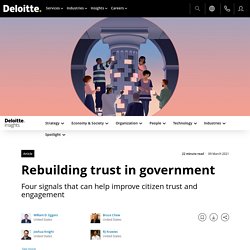
Not all have negative scores individually, but, as with educators, this is a relatively narrow spread from top to bottom performers. Thus, even the best scores for enforcers are quite low compared with most other agencies. These results are concerning, especially the negative scores for humanity and transparency. But these results are a snapshot at a moment in time, and agencies that act as enforcers have shown in the past that they do have the ability to enhance trust through their actions. Trusted Leader: 8 Pillars That Drive Results (30 March 2021) by David Horsager. Journal of Change Management by Rune Lines, Marcus Selart, and Svein Tvedt Johansen. A mini compendium on trust. 3 Ways to Promote Psychological Safety in Your Team. You may have some experience working in a culture that doesn’t feel psychologically safe.
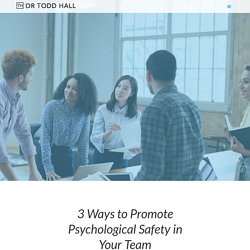
Awhile back I worked with a woman whose department was so unsafe and dysfunctional that she ended up with diagnosable anxiety and depressive disorders, requiring months of psychotherapy. Her bosses were downright rude and showed no care for her as a person whatsoever. When she finally was able to find another job, her health improved dramatically. When you’re stressed out, and feel your environment is unsafe, you can’t focus on your work, much less excel at it. Many leaders know this at some level, but the pressures of profits and hitting goals often crowd out any desire to focus on creating a culture of psychological safety at work. What falling robots reveal about the absurdity of human trust. Taking a final glance at your partner, you turn away, close your eyes, and cross your arms over your chest.
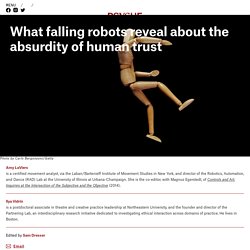
With a deep breath, you exhale and slowly shift your weight backwards. Who’s In Your Circle of Trust? If you’ve seen the movie Meet the Parents, you probably remember “the circle of trust.”
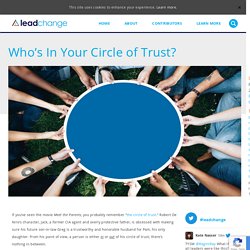
Robert De Niro’s character, Jack, a former CIA agent and overly protective father, is obsessed with making sure his future son-in-law Greg is a trustworthy and honorable husband for Pam, his only daughter. From his point of view, a person is either in or out of his circle of trust; there’s nothing in between. Effective leaders have learned to have multiple circles, each with varying degrees of trust, depending on the people, context of the relationship, and the circumstances involved. Consider these three circles of trust: The outermost circle is the Community and is the group of individuals that you would consider your acquaintances. The Crowd circle contains those relationships that have a deeper level of trust characterized by personal knowledge of each party.
The innermost circle is the Core. Contrary to what’s portrayed in Meet the Parents, there isn’t just one circle of trust. Mutual Trust Between Leader and Subordinate and Employee Outcomes (2016) On psychological safety. Psychological safety and leadership development. When employees feel comfortable asking for help, sharing suggestions informally, or challenging the status quo without fear of negative social consequences, organizations are more likely to innovate quickly, unlock the benefits of diversity, and adapt well to change—all capabilities that have only grown in importance during the COVID-19 crisis.
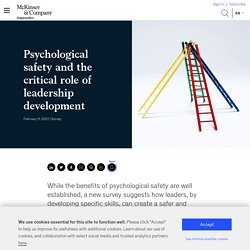
Yet a McKinsey Global Survey conducted during the pandemic confirms that only a handful of business leaders often demonstrate the positive behaviors that can instill this climate, termed psychological safety, in their workforce. Audio As considerable prior research shows, psychological safety is a precursor to adaptive, innovative performance—which is needed in today’s rapidly changing environment—at the individual, team, and organization levels.
Fortunately, our newest research suggests how organizations can foster psychological safety. Global report: 2021 Edelman Trust Barometer. Global Pandemic Puts Trust to the Test The Covid-19 pandemic, with more than 1.9 million lives lost and joblessness equivalent to the Great Depression, has accelerated the erosion of trust around the world.
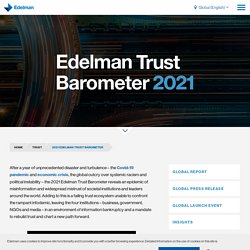
This is evident in the significant drop in trust in the two largest economies: the U.S. and China. The U.S. (40 percent) and Chinese (30 percent) governments are deeply distrusted by respondents from the 26 other markets surveyed. How Digital Trust Varies Around the World. Three Ways To Build Trust During Times of Change. Conventional wisdom about change management puts a great deal of emphasis on strategy.
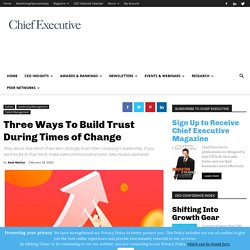
While those big decisions are important, even the best strategy is meaningless unless it’s implemented on the ground. Successful execution, in turn, depends on the people involved—and how much they trust their leadership. If employees believe in the larger vision and can see how pursuing that vision makes sense for them and for the business, that buy-in will translate to better work and more effective strategy execution.
What are you doing to perpetuate “psychological safety” for others in your organization? It's not psychological safety if people can only voice what you want. Psychological Safety - A Product of Outputs and Outcomes. Psychological safety was coined in 1965 by Edgar Schein and Warren Bennis and has since been advanced rather famously by Amy Edmondson at Harvard Business School.
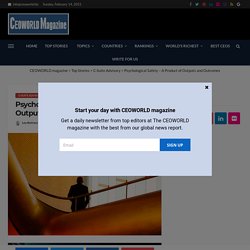
That said, it didn’t become part of the business leaders’ lexicon until Google identified it as critical to high-performing teams as part of its Project Aristotle. Understanding the value (in theory) of psychological safety for a team is one thing. Embracing it and recognizing what it takes to leverage it and keep it is quite another. Based on what I’ve learned during the workshops I lead for CEO peer groups and cross-functional work teams, it’s a combination of how employees choose to engage one another and the positive outcomes they achieve as a result. Psychological Safety is a Journey, Not a Destination If you’re serious about creating a psychologically safe environment in your organization, then at a minimum, these are the conditions and behaviors that CEOs identify as being essential: Why Efficacy Matters, Too Summary Summary. How To Get Your Team To Trust You - 5 Crucial Tips.
WFH Is Corroding Our Trust in Each Other. In early 2020, the switch to remote or hybrid work was abrupt for many companies.

While employees were willing to give one another some latitude earlier in the pandemic, now, almost a year in, their trust is wearing thin, and some find... About a third of the employees of a regional bank have returned to working onsite, and the president holds a weekly all-staff town hall meeting by videoconference. Employees are encouraged to submit anonymous questions for him or other senior leaders to answer. For the past six weeks, an increasing number of people have asked, “How do we know if the people who are still working from home are actually working?” On psychological safety. Fun ways new managers can build trust with remote teams. Trust, Leadership Style and Generational Differences at Work – A Qualitative Study of a Three-Generation Workforce from Two Countries (2018)
3 ways to fight corruption and restore trust in leadership. As people around the world place their trust in the production and distribution of a COVID-19 vaccine, we must ensure corruption does not get in the way.
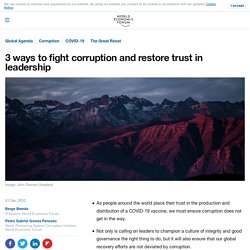
Not only is calling on leaders to champion a culture of integrity and good governance the right thing to do, but it will also ensure that our global recovery efforts are not deviated by corruption. Here are three ways to overhaul our approach to combatting corruption. As we identify the paths necessary to come out of this compounded COVID-19 crisis and prepare the conditions for a much-needed Great Reset, we must also keep the focus on long-standing challenges that will affect this recovery - most notably the fight against corruption and the search for greater trust and integrity in institutions across social, economic and political systems.
Technology has emerged as one of the greatest allies of transparency and a critical tool against corruption. —Børge Brende and Pedro Gabriel Gomez Pensado. Journal of Applied Social Psycholog by Tvedt Johansen, Marcus Selart and Kjell Grønhaug. Does your company trust you? Looking back, the industrial revolution led to the conception that people are naturally unmotivated and seek to take maximum advantage of their employer. But during the 60’s, a shift started to happen. The thesis that employees needed to be controlled got questioned. Trust in change managers: the role of affect (2012) To Build Trust, Get Real. And ideas aren’t all people won’t offer up when they feel unsafe being themselves. Our research also shows that Introverts are less likely to feel they can be honest with their manager about their stress levels. And when managers aren’t aware of how people are feeling or coping with stress, it can be difficult for them to help.
How to know who’s trustworthy. The most important mark of intellectual dependability is that someone genuinely cares about your intellectual wellbeing. They want to help you get to the truth, gain knowledge, deepen your understanding, and develop your skills for enquiry. They possess the foundational virtue of intellectual benevolence. As a virtue, intellectual benevolence involves patterns of emotion and thought, not just actions. The intellectually benevolent person cares when other people make intellectual gains, and takes pleasure in this. Showing Up: Strategies to Gain Executive Trust and Earn Your Seat at the Table. It’s 2020.
Every day is full of surprises. As internal communication professionals, we’ve been thrust into the spotlight and our journey to executive adviser is now set to warp speed. We’re being called on to strategically manage reputational risks, organizational change, pandemic responses, employee engagement, virtual workplaces, mental health initiatives and more. Medical Community's Success Against COVID-19 Hinges on Trust. Unlike other global crises, where we would typically expect financial bodies or the military to take the lead, we are relying on the global medical community -- including our own doctors and nurses -- to guide us through the current COVID-19 pandemic. There are many important factors to consider in assessing the global medical community's ability to successfully do this, including its operational capability and decision-making structures and communication plans. But another essential element is whether citizens themselves trust these institutions.
Recently, at the annual Meridian Summit, I shared a number of Gallup insights into how people around the world perceive the medical community, based on research from Gallup's World Poll and the Wellcome Global Monitor. (Video courtesy of the Meridian International Center) Post–COVID-19: Trust in the workplace. Trust development in workplace relations during change: A multi-level analysis of narratives from leaders and followers (2017) Vulnerability and trust in leader-follower relationships (2015) According to an FBI Behavior Expert, These 10 Techniques Quickly Build Trust with Anyone. Trust is not the last to die (2016) LinkedIn by Gary Vaynerchuk. Journal of Organizational Change Management by Roy K Smollan. The importance of psychological safety in the workplace. Trust in 3 models. Trust me, it’s simple. Podcast: Trust and Change (Part 1), With Stephen W. Maye. Building trust to enhance employee potential and leave your people and your business Net Better Off.
The CHRO is a catalyst for growth The CHRO has emerged as one of the most vital roles in the C-suite, as organizations work to keep employees safe, employed, supported and equal. How employers can boost trust and empathy. These methods will help HR leaders address transparency and empathy gaps with the workforce, especially when change is the only reliable constant. The coronavirus pandemic has sent shockwaves rippling across the globe, infiltrating nearly every aspect of our personal and professional lives. In response to the global pandemic, Kotter’s COVID-19 Study of 850 respondents revealed that less than a third of respondents believe their organization will come out stronger after COVID-19 compared with the market, with top-level executives exhibiting more confidence than mid- to junior-level employees. Trust Happens: A Multi-route Model of Trust Formation In Virtual Teams (2012)
The effects of changing power and influence tactics on trust in the supervisor: A longitudinal field study (2011) Trust is the cornerstone of any major organizational change. Journal of Organizational Behavior by Ana Cristina Costa, C. Ashley Fulmer and Neil R. Anderson. What a Trusting Team Feels Like. Trust. But Verify. “Things are not quite as they seem.” It’s a powerfully useful quote, attributed to the Roman writer Phaedrus. That’s not all of the quote, though. It continues on, “The first appearance deceives many; the intelligence of a few perceives what has been carefully hidden.” One of the great truths of life is not just that things are not as they seem, but that they are never—or very rarely—as they seem. What you get is not just what it says on the tin; sometimes it is much less, and occasionally it is much, much more. Harvard Business Review. Trust vs. Performance: How to identify who the toxic person in your team is.
Repairing and Enhancing Trust: Approaches to Reducing Organizational Trust Deficits (2010) What Does The Trust Meter Say? In case there is any doubt, a culture of trust is vital to the work that we do as change practitioners. You may be able to drive short-term, looking-over-the-shoulder compliance through authoritarian, top-down dictate; but deeply embedded change requires trust. How to Foster Psychological Safety in Virtual Meetings. Second Chances with Bruce Deel - A Bit of Optimism (Podcast): Episode 13. Journal of International Business Studies by Helene Tenzer Markus Pudelko Anne-Wil Harzing.
How to Build Trust and Boost Productivity Within Remote Teams. Story Highlights The question of the year: Are remote teams productive? Inquisitive managers can get to the root of team productivityAsk the right questions to set your remote teams up for success. Four Steps To Repair Broken Trust. This moment is a high-stakes test for business leaders. While the Covid-19 pandemic threatens the financial viability of many organizations, an even more fragile and vital resources is at risk: the trust between the leader and the employees. The Hauser Center for Nonprofit Organizations Harvard University by Michael Pirson. Trust is not the last to die (2016) by Vitor Seco and Miguel Pereira Lopes.
How to build trust at work, according to a Salesforce SVP. Organizational Transparency: A New Perspective on Managing Trust in Organization-Stakeholder Relationships (2014) Measuring and Managing Stakeholder Trust (2008) Measuring trust in organisational research: Review and recommendations (2011) Exploring the Pyramid of Trust. Category:Collaboration,Community,Connections,Creation Spaces,Emotions,Passion,Trust Trust is eroding in all our institutions around the world. Most people are aware of the many surveys documenting this, but few have really explored why this trust is eroding, much less what we need to do to restore trust. What Matters to Whom: Managing Trust Across Multiple Stakeholder Groups (2007) by Michael Pirson and Deepak Malhotra.
Foundations of Organizational Trust: What Matters to Different Stakeholders (2010) by Michael Pirson and Deepak K. Malhotra. Organizational trust and performance: Is organizational learning capability a missing link? (2013) At What Level (and in Whom) We Trust: Trust Across Multiple Organizational Levels (2012) Trust, distrust and human resource management (2019) by Neve Isaeva, Mark N K Saunders and Colin Hughes. Psychological-safety leadership in a time of flux.
We are living through a period of extraordinary uncertainty—about our physical safety, our economic security, and the daily conditions in which we will be operating for the next six, 12, 18 months or longer. One consequence: an undercurrent of emotional disturbance characterized by rising levels of anxiety, depression, fear, and stress. At the same time leaders are confronting these challenges on an individual level, they also are responsible for supporting a wide cross-section of people, all of whom have their own range of experiences, emotions, and resources for responding—and many who are paying a psychological toll that is still poorly understood. Audio Aaron De Smet: Physical safety is obviously very high on everyone’s list right now. Yet in this period where people are also experiencing some form of anxiety, depression, grief, and fear, does that make the challenge of creating a psychologically safe environment easier or harder? Video. Building trust during COVID-19 recovery.
Remote working: why trust has never been more important. Remote working: why trust has never been more important. Social networks are broken. Here's how to rebuild trust. eBook: Power and Trust. Saving Face: How to Preserve Dignity and Build Trust (June 2020) by Maya Hu-Chan. Énergie et confiance : les clés pour créer notre « prochain normal »
The 4 Stages of Psychological Safety: Defining the Path to Inclusion and Innovation (2020) by Timothy R. Clark. Building trust during COVID-19 recovery. Creating a High Trust Culture: Who is Responsible? Trust is the key ingredient. Book Club with Simon Sinek. 7 Signs Your Co-Workers Don't Trust You. Trust Barometer 2020 - Special Report: Brand Trust and the Coronavirus Pandemic. Baromètre de confiance 2020 - Rapport spécial : La confiance envers les marques durant la pandémie de coronavirus. Everything Starts with Trust. LinkedIn by Dr Jen Frahm. Trust in Leadership - One Key Factor During Organizational Change. 3 Common Mistakes That Prevent Leaders from Building Trust. Transformation requires trust. How to build trust on remote teams.
Virtual Working – how to build trust. Episode 83 of #commcast - As a leader, how do you build trust in your virtual teams? TRUST IN MANAGEMENT, COMMUNICATION AND ORGANISATIONAL COMMITMENT - FACTORS INFLUENCING READINESS FOR CHANGE MANAGEMENT IN ORGANISATION (2017) The No. 1 Reason You Might Be Losing Your Best People. OD08: Differences in assessing trust ∙ Team performance, capability & capacity ∙ Tweet for Thought ∙ Diagnostic tools.
How to Trust People. Why Trust Is Important. Not Born Yesterday: The Science of Who We Trust and What We Believe (2020) by Hugo Mercier. Three Ways To Build Trust During Times of Change. People are more trustworthy than you think.